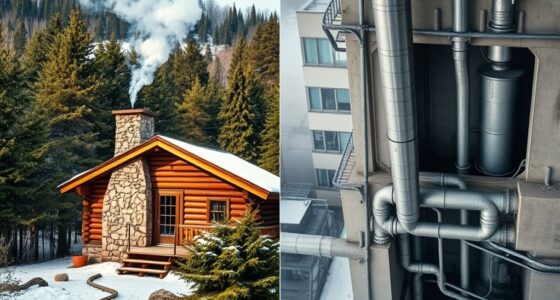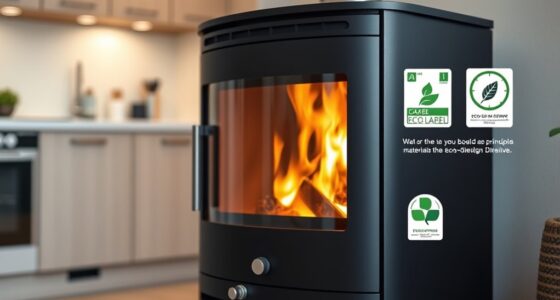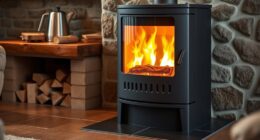Wood stoves are a cost-effective, renewable heating option that delivers cozy, radiant heat, especially good for small spaces. They require regular maintenance, space for firewood, and proper ventilation to avoid issues. Compared to electric, gas, or pellet systems, they offer high efficiency but need more effort to operate and install. Understanding their benefits and drawbacks helps you choose the best method — explore further to find the right fit for your home.
Key Takeaways
- Wood stoves are cost-effective and eco-friendly but require space, regular maintenance, and firewood sourcing.
- They provide localized radiant heat ideal for small homes, whereas furnaces and heat pumps suit larger spaces.
- Installation complexity varies, with wood stoves needing chimney setup and central systems requiring professional installation.
- Fuel costs for wood stoves are lower, but they demand manual labor for wood chopping and storage.
- Modern systems like heat pumps and EPA-certified stoves offer lower emissions and higher efficiency, aligning with environmental goals.
The Natural Warmth of Wood Stoves
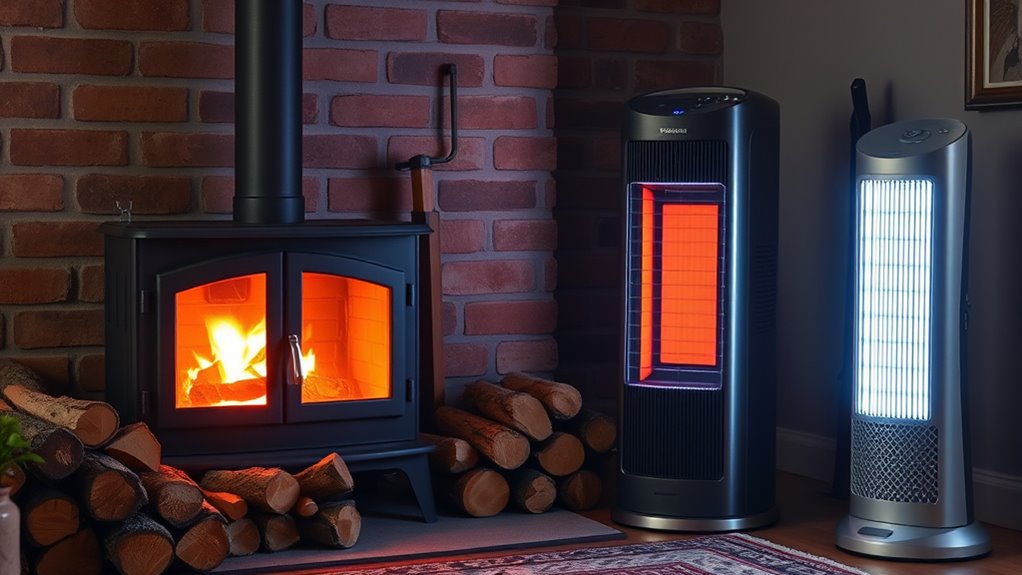
Wood stoves have long been valued for their natural, comforting warmth, providing more than just heat—they create an inviting atmosphere that connects you to nature. When you use a wood stove for heating, you experience radiant heat that feels soothing and authentic. The crackling fire and glowing flames add a cozy ambiance that’s hard to match with other methods. Modern wood stoves are designed to maximize heat output while minimizing emissions, making them an eco-friendly choice. Plus, wood is generally more affordable than fossil fuels, helping you save money and promoting energy independence through local sourcing. During cold seasons, a wood stove delivers reliable warmth that can make your home more comfortable and inviting, creating a natural, timeless connection to the outdoors. Additionally, the use of sustainably sourced wood supports environmental sustainability and responsible forestry practices. Incorporating renewable fuel sources in your heating options further enhances the eco-friendliness of using wood stoves. Using a wood stove can also reduce reliance on non-renewable energy, further benefitting the environment.
Advantages of Wood Stoves
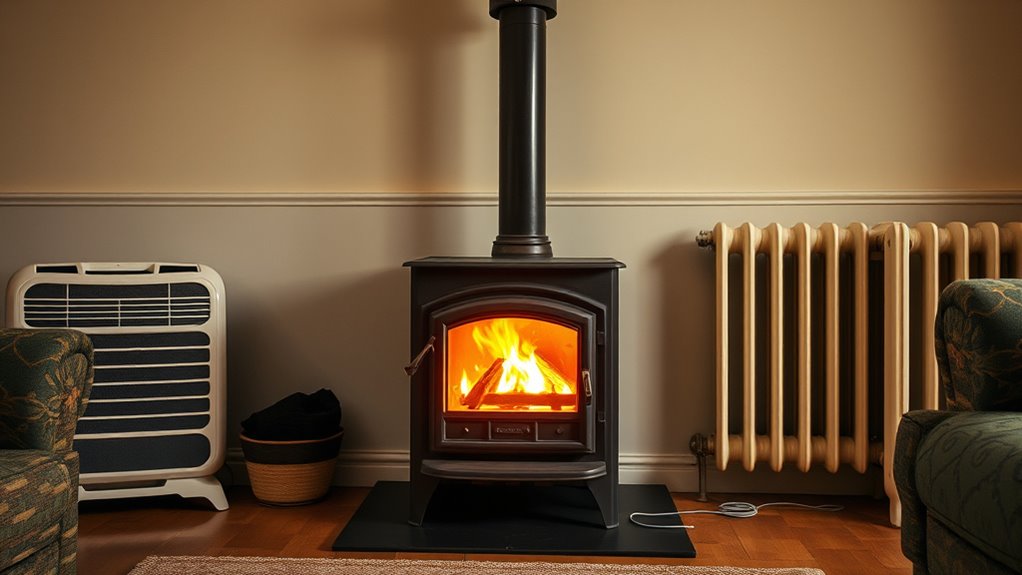
One of the main advantages of wood stoves is their cost-effectiveness; with firewood costing around $350 per cord and providing roughly 22.1 MMBTU of heat, they can substantially reduce your heating expenses. Modern wood stoves are highly efficient, reaching up to 80% efficiency, which maximizes heat output while minimizing fuel consumption. They also harness a renewable resource—firewood sourced locally—giving you greater energy independence. This reliance on a renewable resource means you’re less affected by fluctuating fuel prices and supply disruptions. Additionally, many models feature eco-designs that emit low levels of pollutants, making them a more environmentally friendly option. Overall, wood stoves combine efficiency, affordability, and sustainability, making them a compelling choice for those seeking reliable, eco-conscious heating. Advancements in heating technology continue to improve the efficiency and environmental performance of wood stoves, making them an increasingly attractive option.
Disadvantages of Wood Stoves
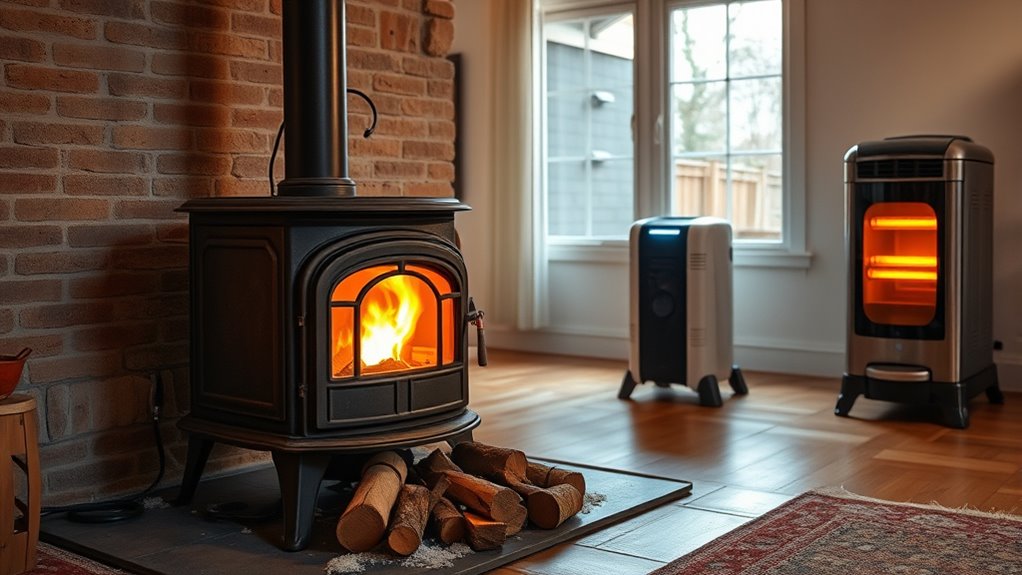
Despite their benefits, wood stoves come with notable drawbacks that can impact convenience and practicality. Managing a wood stove requires:
- Dedicated firewood storage, which can take up valuable space, especially in small or urban homes.
- Regular maintenance, including ash removal and chimney cleaning, to keep it operating safely and efficiently.
- Frequent checks of seals and parts to ensure proper combustion, leading to ongoing upkeep.
- Labor-intensive firewood handling, which involves chopping, stacking, and hauling, making it less convenient than other heating options.
- The need to monitor suction power and airflow regulation to maintain optimal operation, which can be a complex process for users unfamiliar with stove mechanics. Additionally, airflow adjustments often require precise tweaks to prevent smoke spillage and ensure efficient burning. Proper ventilation is crucial to prevent indoor air quality issues. Incorrect airflow management can also lead to increased creosote buildup, raising the risk of chimney fires.
These factors can be time-consuming and challenging, especially if space is limited or if you prefer low-maintenance heating solutions. Overall, firewood storage and maintenance can be significant hurdles with wood stoves.
Comparing Electric, Gas, & Pellet Heating Systems
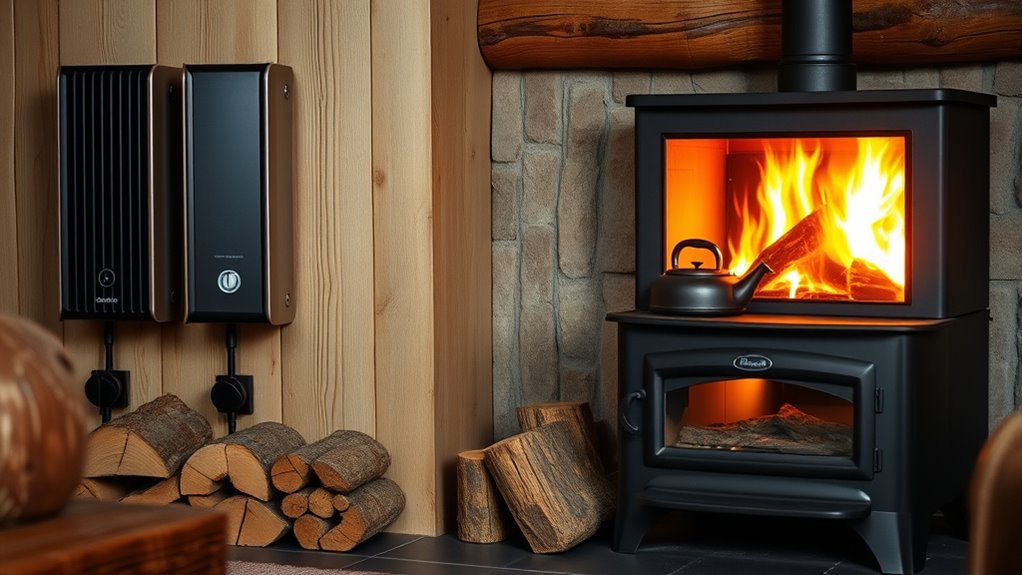
When considering alternative heating options, electric, gas, and pellet systems each offer distinct advantages and challenges. Electric heating provides instant warmth and is easy to install, but it tends to have higher long-term costs because electricity prices are rising. Gas heating delivers reliable, quick heat with low maintenance, making it a popular choice. However, it relies on fossil fuels, which emit greenhouse gases and impact the environment. Pellet heating systems are highly efficient, using renewable biomass pellets and often featuring programmable controls for convenience. While electric and gas systems can quickly heat spaces, pellet stoves require fuel storage and regular upkeep, affecting convenience. Additionally, refrigerants and environmental impact is a key consideration when choosing among these options. Proper refrigerant management and the move toward low-GWP refrigerants help minimize environmental risks associated with heat pump systems. Dog names are also an important aspect to consider when choosing a pet, but in your heating system decision, focusing on efficiency, environmental concerns, and ease of use is essential. Moreover, integrating creative problem-solving skills can help homeowners find innovative ways to optimize their heating solutions and reduce costs. For example, implementing proper insulation and sealing techniques can significantly improve overall energy efficiency. Overall, your choice depends on balancing efficiency, environmental concerns, and ease of use.
Heat Output and Capacity Differences
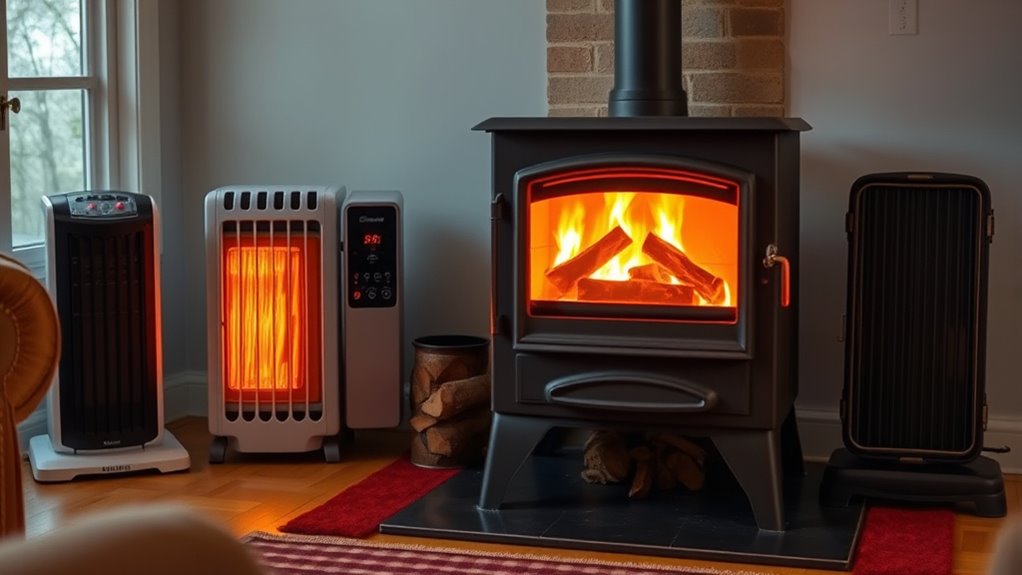
Your choice of heating method depends heavily on the heat output and capacity needed for your space. Wood furnaces deliver nearly twice the heat of high-capacity stoves, making them ideal for larger homes, while stoves suit smaller areas up to 2,000 sq. ft. Keep in mind that larger fireboxes in furnaces mean shorter burn times despite their higher power. State tax implications can influence the overall cost-effectiveness of your heating choices. Additionally, understanding projector technology can help you choose the most efficient and cost-effective heating system for your needs. Being aware of regional legal resources may also assist in selecting systems that comply with local regulations and benefit from incentives.
Heating Power Comparison
How do wood stoves and furnaces compare regarding heating capacity? Wood stoves usually produce between 8,000 to 80,000 BTUs per hour, suitable for heating around 2,000 sq. ft., while wood furnaces generate 80,000 to over 200,000 BTUs, effectively covering larger areas up to 3,500 sq. ft. or more. Consider these points:
- Furnaces have nearly double the heat output of high-capacity stoves.
- The highest heat output of a wood stove is about half that of a furnace.
- Furnaces distribute heat evenly via ductwork, while stoves mainly radiate into a single space.
- Firebox size influences heating capacity—furnaces have larger fireboxes, enabling longer burn times.
- Proper maintenance and system efficiency are essential to ensure safe and effective operation of any heating system.
- Additionally, installation complexity varies significantly, with furnaces often requiring more extensive setup compared to standalone stoves. Your choice depends on the needed heating power, with stoves suited for smaller spaces and furnaces for whole-home heating.
Room Size Suitability
Choosing the right heating method depends heavily on your home’s size and the capacity of the heating system. For smaller rooms or homes up to about 2,000 sq. ft., a wood stove provides enough heating capacity with BTUs ranging from 30,000 to 80,000, delivering radiant heat suited for localized warmth. If your home is larger, exceeding 3,500 sq. ft., a wood furnace offers greater heating capacity, often over 100,000 BTUs, making it ideal for whole-house heating. Wood stoves are best for specific rooms or small spaces, while wood furnaces efficiently heat larger areas. Matching your room size with the heating capacity of the system ensures you stay warm without wasting energy or overpaying. Additionally, water parks in various locations often feature indoor options that can provide heat and fun year-round, which can be a cozy alternative during colder months. Understanding heating efficiency helps in selecting the most suitable method for your needs and ensures optimal comfort and cost-effectiveness. Properly assessing your energy needs can also lead to more effective heating solutions tailored to your home’s specific requirements. Considering cost-effective options and available financing can help make your heating upgrade more affordable and sustainable. To make an informed choice, consider consulting heating professionals who can evaluate your space and recommend the best system.
Burn Time Variations
While both wood stoves and furnaces require refueling 2-3 times daily, their burn times and heat outputs can vary considerably. Here’s what influences burn time:
- The size and design of your firebox, affecting how long firewood burns.
- Outside temperatures, with colder weather shortening burn times.
- Firewood quality, where dry, seasoned wood burns longer.
- The system’s heat capacity, with furnaces producing more heat but consuming firewood faster.
- The type of heating method, such as the use of headphones to monitor audio, which can be essential for maintaining comfort during extended heating periods.
Generally, small wood stoves provide longer burn times relative to their size, ideal for steady heat. Larger furnaces, offering higher heat output, tend to burn through firewood more quickly. Understanding these variations helps you choose the right method for your heating needs.
Heating Area and Home Suitability
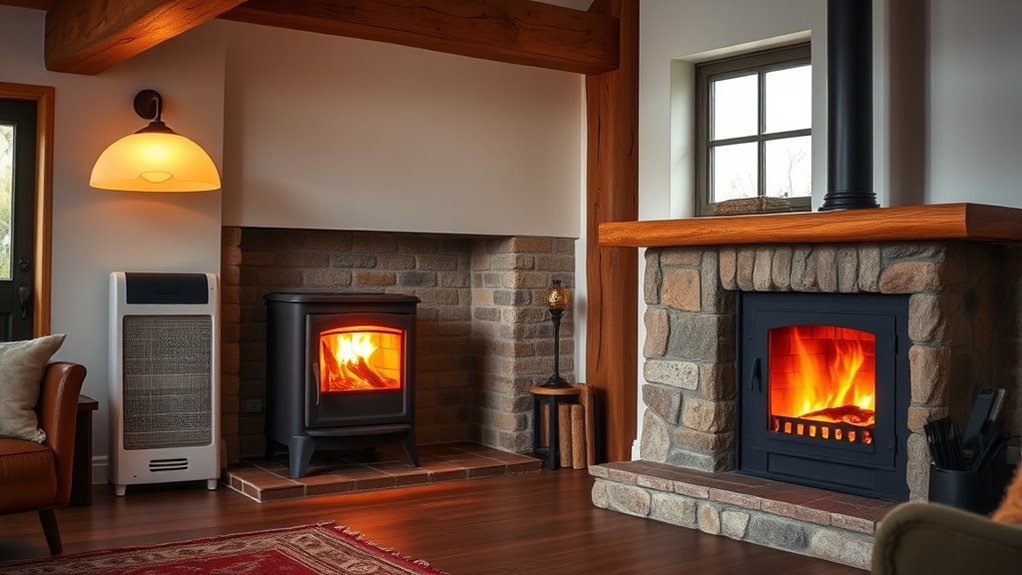
Wood stoves are best suited for small to medium-sized homes or specific rooms, typically heating areas up to around 2,000 square feet. If your home falls within this range, a wood stove can provide efficient, localized warmth without overcapacity. They are ideal for those who want a cozy, spot-heating solution or a supplemental heating system. Larger homes or spaces requiring whole-house heating are better served by wood furnaces, which can cover 3,500 square feet or more. Your choice depends on your home size and heating needs. For smaller residences or single-room areas, a wood stove offers a practical, effective solution. However, if your home is larger, consider a different heating system better tailored for extensive coverage.
Burn Time and Fuel Efficiency
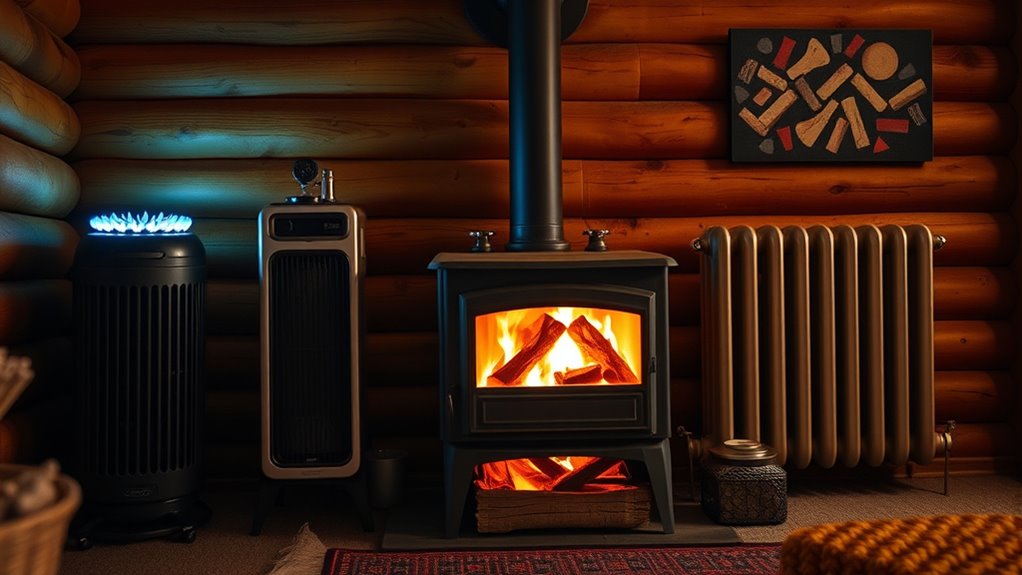
When comparing burn time and fuel efficiency, you’ll notice that wood stoves often last longer per load than wood furnaces because of their design. Fuel consumption varies based on wood type and stove model, with seasoned hardwood delivering the best efficiency. Unlike natural gas furnaces, which run continuously without refueling, wood stoves require regular top-ups but can be more fuel-efficient overall.
Burn Duration Comparison
Compared to furnaces, wood stoves often provide longer burn times per load, thanks to their design and smaller heat output. This means you can enjoy a steady heat source without frequent refueling. Here’s what influences burn time:
- Firewood moisture content — dry firewood burns longer and more efficiently.
- Stove size — larger fireboxes hold more firewood, extending burn duration.
- Outside temperature — colder weather may shorten burn times as more heat is needed.
- Desired warmth — higher temperature settings can decrease burn time due to increased fuel consumption.
Typically, a load of firewood in a wood stove can last anywhere from 4 to 12 hours, depending on these factors. You get a longer, more consistent burn compared to the shorter, more intense heat from other methods.
Fuel Consumption Efficiency
Fuel consumption efficiency in wood stoves hinges on how well they convert firewood into usable heat, which depends on stove design, burn time, and fuel quality. Modern EPA-certified stoves reach efficiencies around 70-80%, meaning you get more heat from each load of firewood. This improved fuel efficiency reduces your firewood costs by maximizing energy output and minimizing wasted fuel. Since firewood costs roughly $350 per cord, burning dry, seasoned wood effectively makes wood stoves a cost-effective heating option. Burn times vary based on stove capacity, insulation, and airflow, but most need refueling every few hours during cold weather. When optimized, wood stoves use less fuel for comparable heat output compared to oil or electric systems, helping you save on fuel expenses over time.
Cost and Installation Considerations
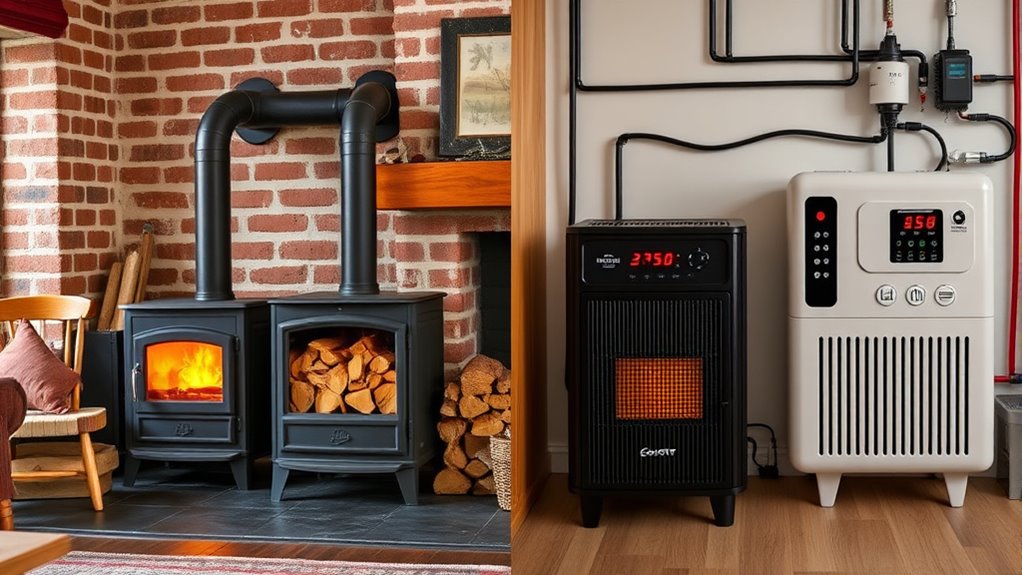
Although wood stoves generally cost less upfront than central heating options like heat pumps or furnaces, their installation involves specific expenses you should consider.
Here are four key factors:
- The cost of installation, ranging from $1,000 to $3,000, depending on chimney setup, hearth materials, and permits.
- The need for a chimney and proper venting, which adds to installation complexity and expense.
- Space requirements for firewood storage and clearance, influencing where you can place the stove.
- The importance of professional installation to ensure safety, code compliance, and peak performance, which can increase total costs.
While the initial cost may be lower, understanding these factors helps you plan for the full expense of installing a wood stove.
Environmental Impact and Sustainability
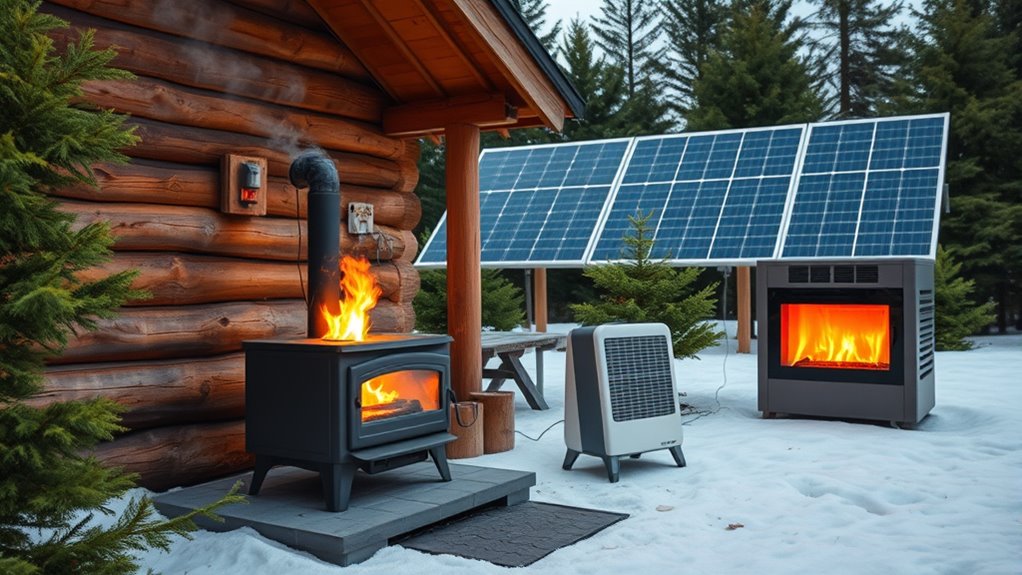
Wood stoves, especially EPA-certified models, are considered environmentally friendly when you use sustainably sourced, seasoned firewood, as they produce low emissions and particulate matter. Their environmental impact is minimal compared to older, non-certified models. However, they still rely on biomass, which can impact local forests if not sourced sustainably. Pellet stoves offer a cleaner-burning alternative by utilizing compressed renewable biomass, reducing air pollutants further. Natural gas stoves emit fewer pollutants but depend on fossil fuels, affecting long-term sustainability. Passive solar heating and high-efficiency heat pumps operate entirely on renewable resources, generating no onsite emissions and enhancing overall sustainability. Choosing renewable fuel sources and environmentally certified appliances is key to reducing your heating system’s environmental impact and ensuring long-term sustainability.
Choosing the Right System for Your Home

Choosing the right heating system depends on your home’s size, your priorities, and your lifestyle. To make an informed decision, consider these factors:
- Is your space small or large? Wood burning stoves work well in small spaces, while heat pumps or furnaces are better for bigger areas.
- How important is energy independence? Wood stoves use renewable fuel, aligning with eco-friendly values, whereas electric and gas systems may have higher carbon footprints.
- What about installation and maintenance? Wood stoves need dedicated space, fuel storage, and regular upkeep, while electric systems are portable and require less maintenance.
- What’s your budget? Wood stoves often have lower fuel costs but higher upfront costs, whereas heat pumps and electric systems might be more affordable initially but cost more over time.
Frequently Asked Questions
What Is Better Than a Wood-Burning Stove?
When you ask what’s better than a wood-burning stove, it depends on your needs. Gas fireplaces give you instant heat and easy control, making them more convenient. Pellet stoves are efficient and programmable, offering modern comfort. Central heat pumps provide consistent warmth for large spaces with less effort. Electric heaters are portable and simple, but less effective for big areas. Choose based on your priorities for convenience, efficiency, and space size.
Is It Cheaper to Heat Your Home With a Wood-Burning Stove?
Heating your home with a wood-burning stove can save you more money than you’d believe—like filling your wallet with hundreds of dollar bills! If you have access to sustainably sourced firewood, you’ll find it’s often cheaper than electric or oil systems. Sure, there’s some upfront cost and maintenance, but over time, your fuel expenses drop dramatically. For many homeowners, it’s the most economical and eco-friendly way to stay warm.
Do Fireplace Inserts Heat as Well as Wood Stoves?
You might wonder if fireplace inserts heat as well as wood stoves. Generally, they don’t. Fireplace inserts usually produce less heat, around 30,000 to 50,000 BTUs, compared to wood stoves that can reach 60,000 to 100,000 BTUs. Inserts rely on your existing fireplace structure, which limits their capacity. If you need stronger, more consistent warmth, a dedicated wood stove typically performs better than a fireplace insert.
What Is the Best Alternative to a Wood Burner?
Imagine finding a reliable, efficient friend who warms your home with less effort—that’s what an electric heater can be. For quick, portable warmth, it’s perfect, especially in small spaces. While it doesn’t match the ambiance of a wood burner, it’s easy to install and cost-effective. If you want a simple, immediate alternative, an electric heater is your best bet, especially for spot heating or supplemental warmth.
Conclusion
Choosing the right heating method is like finding the perfect song for a drive—each option sets a different mood. Wood stoves bring a cozy, natural glow, but other systems might suit your lifestyle better. Consider heat output, efficiency, and environmental impact to make an informed choice. Whichever path you take, guarantee it warms your home and heart, turning your space into a sanctuary where comfort and sustainability harmonize seamlessly.




